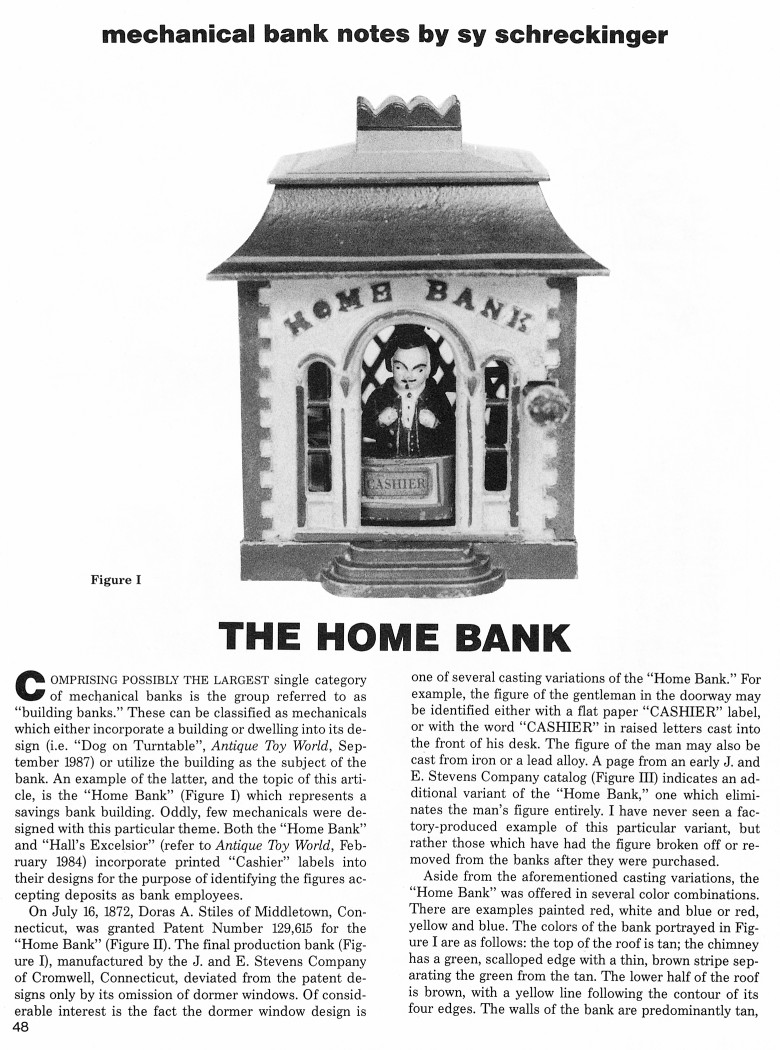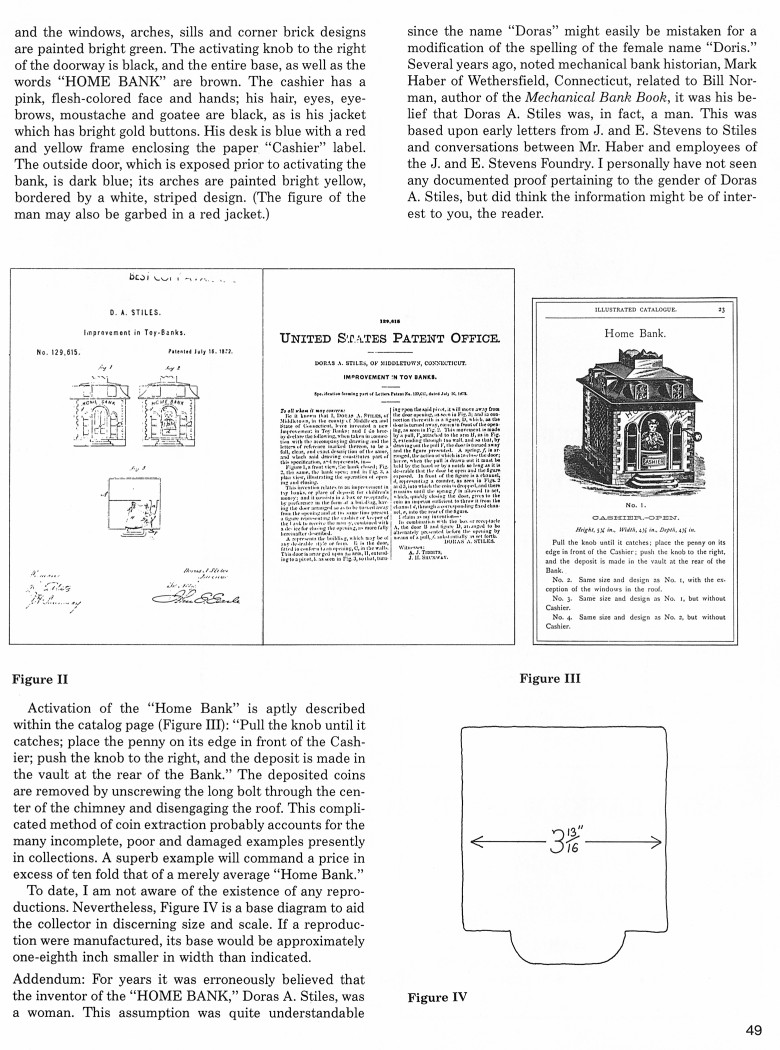|
The Home Bank
by Sy Schreckinger – ANTIQUE TOY WORLD Magazine – January, 1991
Comprising possibly the largest single category
of mechanical banks is the group referred to as "building banks." These
can be classified as mechanicals which either incorporate a building or
dwelling into its design (i.e. "Dog on Turntable", Antique Toy World,
September 1987) or utilize the building as the subject of the bank. An
example of the latter, and the topic of this article, is the "Home Bank"
(Figure I) which represents a savings bank building. Oddly, few
mechanicals were designed with this particular theme. Both the "Home Bank"
and "Hall's Excelsior" (refer to Antique Toy World,
February 1984)
incorporate printed "Cashier" labels into their designs for the purpose of
identifying the figures accepting deposits as bank employees.
On July 16, 1872, Doras A. Stiles of Middletown, Connecticut, was
granted Patent Number
129,615 for the "Home Bank" (Figure II). The final
production bank (Figure I), manufactured by the J. and E. Stevens Company
of Cromwell, Connecticut, deviated from the patent designs only by its
omission of dormer windows. Of considerable interest is the fact the
dormer window design is one of several casting variations of the "Home
Bank." For example, the figure of the gentleman in the doorway may be
identified either with a flat paper "CASHIER" label, or with the word
"CASHIER" in raised letters cast into the front of his desk. The figure of
the man may also be cast from iron or a lead alloy. A page from an early
J. and E. Stevens Company catalog (Figure III) indicates an additional
variant of the "Home Bank," one which eliminates the man's figure
entirely. I have never seen a factory-produced example of this particular
variant, but rather those which have had the figure broken off or removed
from the banks after they were purchased.
Aside from the aforementioned casting variations, the "Home Bank" was
offered in several color combinations. There are examples painted red,
white and blue or red, yellow and blue. The colors of the bank portrayed
in Figure I are as follows: the top of the roof is tan; the chimney has a
green, scalloped edge with a thin, brown stripe separating the green from
the tan. The lower half of the roof is brown, with a yellow line following
the contour of its four edges. The walls of the bank are predominantly
tan, and the windows, arches, sills and corner brick designs are painted
bright green. The activating knob to the right of the doorway is black,
and the entire base, as well as the words "HOME BANK" are brown. The
cashier has a pink, flesh-colored face and hands; his hair, eyes,
eyebrows, moustache and goatee are black, as is his jacket which has
bright gold buttons. His desk is blue with a red and yellow frame
enclosing the paper "Cashier" label. The outside door, which is exposed
prior to activating the bank, is dark blue; its arches are painted bright
yellow, bordered by a white, striped design. (The figure of the man may
also be garbed in a red jacket.)
Activation of the "Home Bank" is aptly described within the catalog
page (Figure III): "Pull the knob until it catches; place the penny on its
edge in front of the Cashier; push the knob to the right, and the deposit
is made in the vault at the rear of the Bank." The deposited coins are
removed by unscrewing the long bolt through the center of the chimney and
disengaging the roof. This complicated method of coin extraction probably
accounts for the many incomplete, poor and damaged examples presently in
collections. A superb example will command a price in excess of ten fold
that of a merely average "Home Bank."
To date, I am not aware of the existence of any reproductions.
Nevertheless, Figure IV is a base diagram to aid the collector in
discerning size and scale. If a reproduction were manufactured, its base
would be approximately one-eighth inch smaller in width than indicated.
Addendum: For years it was erroneously believed that the inventor of
the "HOME BANK," Doras A. Stiles, was a woman. This assumption was quite
understandable since the name "Doras" might easily be mistaken for a
modification of the spelling of the female name "Doris." Several years
ago, noted mechanical bank historian, Mark Haber of Wethersfield,
Connecticut, related to Bill Norman, author of the Mechanical Bank Book,
it was his belief that Doas A. Stiles was, in fact, a man. This was based
upon early letters from J. and E. Stevens to Stiles and conversations
between Mr. Haber and employees of the J. and E. Stevens Foundry. I
personally have not seen any documented proof pertaining to the gender of
Doras A. Stiles, but did think the information might be of interest to
you, the reader.
|


